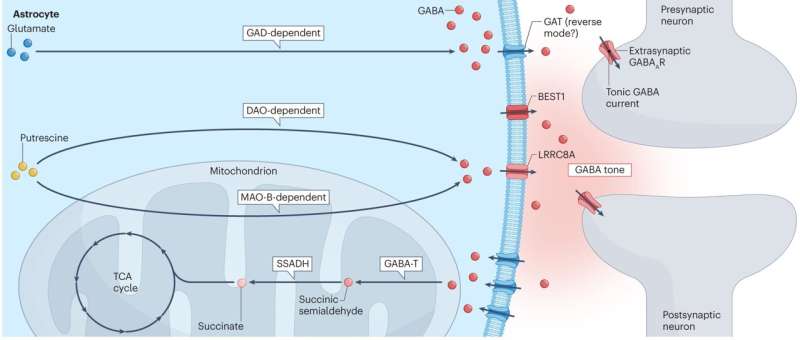This article has been reviewed according to Science X's editorial process and policies. Editors have highlighted the following attributes while ensuring the content's credibility:
fact-checked
peer-reviewed publication
trusted source
proofread
Study reveals new insights into GABA, the brain's key signaling molecule

In a groundbreaking review paper published in Nature Reviews Neuroscience, scientists have shed new light on the role of GABA, a key signaling molecule in the brain.
Researchers from the Center for Cognition and Sociality (CCS) within the Institute for Basic Science (IBS), led by Director C. Justin LEE and Young Scientist Fellow KOH Wuhyun, and Yonsei University team, led by Professor CHEONG Eunji and Postdoctoral Researcher KWAK Hankyul, have delved into how GABA's levels in the brain are regulated and its broader impacts on cognitive function.
Within the realm of brain science, two types of signal transmission are essential: excitatory signals, which prompt the activation of the next neuron, and inhibitory signals, which suppress neuron activity. These functions are mainly controlled by two substances: glutamate and GABA, respectively. While the understanding of GABA's action at the synapse between pre- and post-synaptic neurons has been established, its effects outside the synapse have remained a mystery.
Since 2010, Director Lee has been investigating the cognitive function of astrocytes, a type of brain cell involved in the synthesis, release, and clearance of GABA. His team even identified potential treatments for diseases related to aberrant GABA synthesis, such as dementia, and are pioneering the development of these therapies.
In this new review paper, the IBS-CCS scientists introduced a novel concept called GABA tone, which refers to the amount of GABA that is mediating a continuous (tonic) GABA current in the brain. This work is expected to provide a guideline for understanding the regulation and function of GABA tone, promising advances in brain disease treatment.
The review paper emphasizes three critical points.
- First, dominance of astrocytes in GABA tone regulation: These star-shaped cells synthesize, release, and eliminate GABA tone.
- Second, mechanism of tonic GABA current inhibition: There was a misconception in the literature that inhibition of tonic GABA currents was mediated by hyperpolarization, but this type of inhibition occurs with a specific form of resistance reduction known as shunt inhibition.
- Third, GABA tone's impact on cognitive functions: tonic GABA current affects learning, memory, biorhythm, arousal state, and motor control, demanding further research into additional cognitive functions.
The authors expressed hope that this paper will attract global attention to the functional study of tonic GABA currents initiated by astrocyte research. They see it as a foundational guideline for future research in this fascinating area.
In a world where brain diseases such as dementia continue to rise, this study serves as a beacon of hope and offers a roadmap for unlocking the secrets of the brain. The exploration of GABA, as summarized by the IBS Center for Cognition and Sociality and Yonsei University, sets an exciting course for brain science, opening doors to potential new therapies and a deeper understanding of the body's most complex organ.
More information: Wuhyun Koh et al, GABA tone regulation and its cognitive functions in the brain, Nature Reviews Neuroscience (2023). DOI: 10.1038/s41583-023-00724-7




















